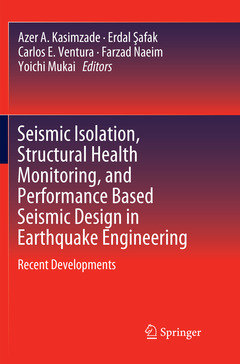Description
Seismic Isolation, Structural Health Monitoring, and Performance Based Seismic Design in Earthquake Engineering , 1st ed. 2019
Recent Developments
Coordinators: Kasimzade Azer A., Şafak Erdal, Ventura Carlos E., Naeim Farzad, Mukai Yoichi
Language: English
Subjects for Seismic Isolation, Structural Health Monitoring, and...:
Publication date: 12-2018
Support: Print on demand
Publication date: 08-2018
Support: Print on demand
Description
/li>Contents
/li>Biography
/li>Comment
/li>
This book features chapters based on selected presentations from the International Congress on Advanced Earthquake Resistance of Structures, AERS2016, held in Samsun, Turkey, from 24 to 28 October 2016.
It covers the latest advances in three widely popular research areas in Earthquake Engineering: Performance-Based Seismic Design, Seismic Isolation Systems, and Structural Health Monitoring.
The book shows the vulnerability of high-rise and seismically isolated buildings to long periods of strong ground motions, and proposes new passive and semi-active structural seismic isolation systems to protect against such effects. These systems are validated through real-time hybrid tests on shaking tables.
Structural health monitoring systems provide rapid assessment of structural safety after an earthquake and allow preventive measures to be taken, such as shutting down the elevators and gas lines, before damage occurs. Using the vibration data from instrumented tall buildings, the book demonstrates that large, distant earthquakes and surface waves, which are not accounted for in most attenuation equations, can cause long-duration shaking and damage in tall buildings.
The overview of the current performance-based design methodologies includes discussions on the design of tall buildings and the reasons common prescriptive code provisions are not sufficient to address the requirements of tall-building design. In addition, the book explains the modelling and acceptance criteria associated with various performance-based design guidelines, and discusses issues such as selection and scaling of ground motion records, soil-foundation-structure interaction, and seismic instrumentation and peer review needs.
The book is of interest to a wide range of professionals in earthquake engineering, including designers, researchers, and graduate students.
Part I: Seismic Isolation Systems
1.1 New seismic isolation systems
1.2 Simple natural seismic isolation systems for buildings with no overturning moment
1.3 Development of resilient seismic response control with a semi-active system
Part II: New Developments on Structural Health Monitoring and Earthquake Early Warning Systems for Performance Assessment of Structures
2.1 BC Earthquake Early Warning System, A Program for Seismic Structural Health Monitoring of infrastructure2.2 Structural Health Monitoring: Lessons learned
2.3 Recent studies on earthquake performance assessment of Hagia Sophia in Istanbul
2.4 Evaluation of historical Merzifon Dönertaş Mosque with a single dome2.5 Analytical and experimental modal analysis of a cold formed steel (CFS) model structure using microtremor excitation
2.6Optimal estimation of dynamic Parameters from ambient vibrations
2.7 Seismicity and tectonics of Black Sea
Part III: Performance Based Seismic Design
3.1 Performance Based Seismic Design of Tall Buildings – A USA Perspective
3.2 Performance-Based evaluation of hydrocarbon steel pipes under internal impact
3.3 Seismic energy demands of inverted V- Braced frames
3.4 A new approach to improving seismic safety based on the energy theory of reinforced concrete resistance3.5 Free flexural vibrations of axially loaded Timoshenko beams with internal viscous damping using dynamic stiffness formulation and differential transformation
3.6 Behavıor of RC square column strengthened with CFRP strips subjected to low velocıty lateral impact loadıng
3.7 Strain-based seismic performance evaluation of prefabricated structures.
Offers a rich source of unpublished data, examples and illustrations
Provides a unique fusion of earthquake engineering, structural modelling of interest to a wide audience of professionals, specialists, researchers and students
Proposes a highly reliable new structural seismic isolation system




